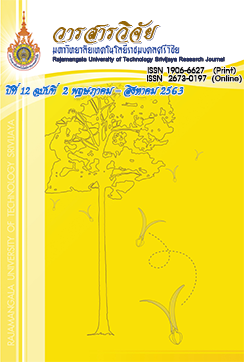Antagonistic Microbe on Palm Soil for Producing of Plant Growth Promoting Rhizobacteria Yeast and Fungal (PGPR) Mixed Microbe
Keywords:
PGPR, antagonistic microbe, 16S rRNA, palm kernelAbstract
Isolation of microorganisms on soil samples after using PGPR analysis of the 1,500-bp nucleotide sequence of the 16S rRNA gene by using the BLASTN program was compared with NCBI's GenBank data with a confidence level more than 99-100 percent. Morphogical characteristics and biochemical characterization taking place at Nong Suea District, Pathum Thani Province, Thailand found 14 isolates of microorganisms: actinomyces is Streptomyces themodiastatics, Fungal 7 isolates: Aspergillus terreus, Aspergillus fumgatus, Aspergillus tamari, Penicillium pennosus, Rhizomucor pusilus and Trichoderma asperelium Bacteria 5 isolates: Bacillus velezensis, Lactobacillus pentosus, Bacillus subtilis, Bacillus flexus and Bacillus lichenifermis: 1 isolates of yeast: Sacharomyces cerevisiac. The PGPR according to the method of Rattanaloeadnusorn (2517), and after the innovative PGPR sowing to sow under palm oil weight of 1 and 2 kg per 3 times per year. For 3 and 5 years old palm trees, it was found that the percentage increasing of palm kernel weight gain after using PGPR was 128.57±1.0% and 123.23±1.0% respectively. Results showed that the microorganisms in the bioproducts accelerated the digestion of nutrients into small molecule compounds and slowly released nutrients to plant roots. Palm oil farmers should turn to the innovative PGPR accelerating the growth, weight increase palm kernel, and weight gain per acre per year.
References
Ahemad, M. and Malik, A. 2012. Bioaccumulation of heavy metals by zinc resistant bacteria isolated from agricultural soils irrigated with wastewater. Bacteriology Journal 2(1): 12-21.
Ahemad, M. and Khan, M.S. 2012. Effect of fungicides on plant growth promoting activities of phosphate solubilizing Pseudomonas putida isolated from mustard (Brassica compestris) rhizosphere. Chemosphere 86(9): 945-950.
Behera, B.C., Yadav, H., Singh, S.K., Mishra, R.R., Set hi, B.K., Dutta, S.K. and Thatoi, H.N. 2017. Phosphate solubilization and acid phosphatase activity of Serratia sp. isolated from mangrove soil of Mahanadi river delta, Odisha, India. Journal of Genetic Engineering and Biotechnology 15(1): 169-178.
Figueiredo, M.V.B., Burity, H.A., Martınez, C.R. and Chanway, C.P. 2008. Alleviation of drought stress in the common bean (Phaseolus vulgaris L.) by co-inoculation with Paenibacillus polymyxa and Rhizobium tropici. Applied Soil Ecology 40(1): 182-188.
Gaur, U. and Miller, B. 1990. Effects of environmental exposure on fiber/epoxy interfacial shear strength. Polymer Composites 11(14): 217-222.
Glick, B.R., Cheng, Z., Czarny, J. and Duan, J. 2007. Promotion of plant growth by ACC deaminase-producing soil bacteria. European Journal of Plant Pathology 119(3): 329-339.
Lavakush, Y.J., Verma, J.P., Jaiswal, D.K. and Kumar, A. 2014. Evaluation of PGPR and different concentration of phosphorus level on plant growth, yield and nutrient content of rice (Oryza sativa). Ecological Engineering 62: 123-128.
Ramesh, G., Borda, J.T, Dufour, J., Kaushal, D., Ramamoorthy, R., Lackner, A.A. and Philipp, M.T. 2008. Interaction of the Lyme disease spirochete Borrelia bugdorferi with brain perenchyma elicits inflammatory mediators from cells as well as glial and neuronal apptosis. The American Journal of Pathology 173(5): 1415-1427.
Rattanaloeadnusorn S. 2017. Inoculants fungal Trichoderma, Mucor and Bacillus for community development based on sufficiency economy philosophy. International Journal of GEOMATE 13(40): 16-23.
Zverlov, V.V. and Schwarz, W.H. 2008. Bacterial cellulose hydrolysis in anaerobic environmental subsystems Clostridium thermocellum and Clostridium Stercorarium, Thermophillic Plant-fiber Degraders. Annals of the New York Academy of Sciences 1125: 298-307.
Xie, H., Pasternak, J.J. and Glick, B.R. 1996. Isolation and characterization of mutants of the plant growth-promoting rhizobacterium Pseudomonas putida GR12-2 that overproduce indole acetic acid. Current Microbiology 32(2): 67-71.
Downloads
Published
How to Cite
Issue
Section
License
The content and information in the article published in Journal of Rajamangala University of Technology Srivijaya It is the opinion and responsibility of the author of the article. The editorial journals do not need to agree. Or share any responsibility.







